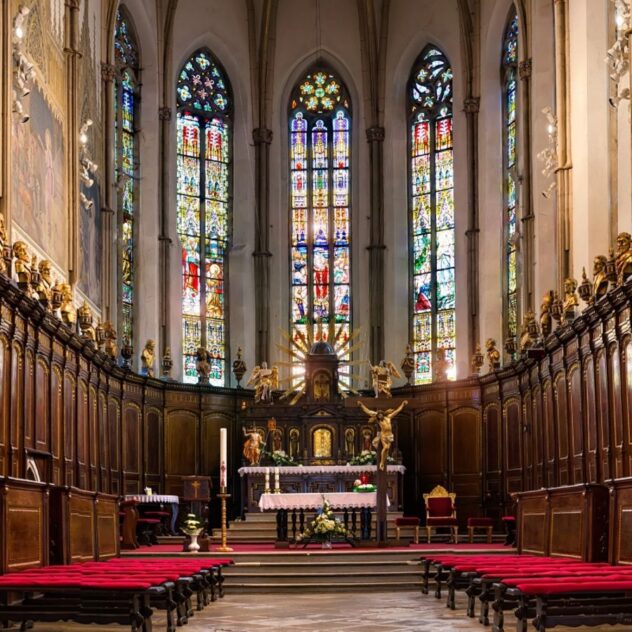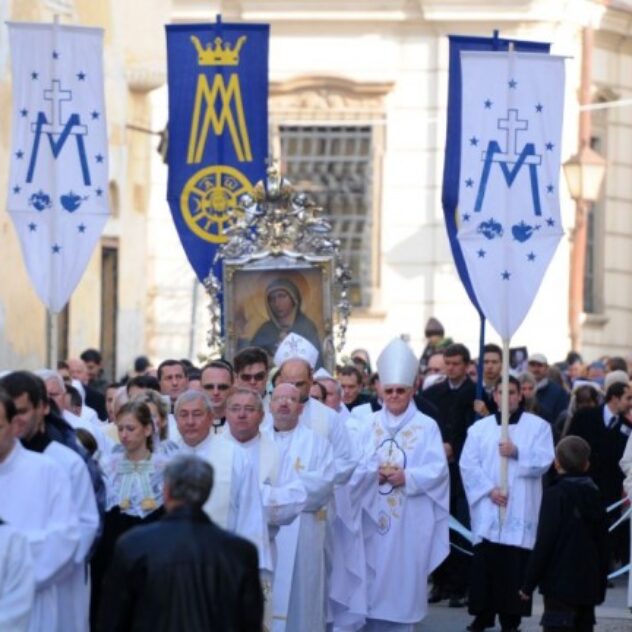Basilica of St. Nicholas with the image of Our Lady of Grace in Trnava
Information about the pilgrimage site
The tradition of pilgrimage to the gracious image of the blessed Virgin Mary of Trnava has a tradition of more than three hundred years. Not only Trnava citizens but also the faithful from the surrounding area come to the Basilica of St. Nicholas (the church has the title “Basilica Minor” since 2008), where the image is placed in gratitude for the graces granted and for saving them from several threats.
The wooden image itself has its origins in Rome. In 1585 it was brought to Trnava by the future archbishop František Forgáč, who was in Rome for his studies. The painting is a faithful copy of an icon from the Monastery of St. Alexius and Boniface in Rome, which he donated to the Church of St. Nicholas, where it hangs to this day.
The first miracle, which is attributed to this painting, took place in 1663, when a danger in the form of a Turkish army was approaching Trnava. The inhabitants gathered at the image of the Virgin Mary, praying for a reprieve from the destruction and devastation caused by the conquering Turks. Here an inexplicable and extraordinary event occurred: the image of the Virgin shed tears of blood and the Turks unexpectedly turned away from the city.
The next threat to the people of Trnava came in the form of a plague epidemic in 1710. The plague spread rapidly and the human casualties kept increasing. The town council could no longer find ways to stop it. Eventually, the distressed inhabitants, led by the town leaders, came before the gracious image of the Virgin Mary, begging for help. After the Holy Mass of supplication, a procession with the gracious Marian image took place from the Church of St. Nicholas through Trnava Square, past the statue of the Holy Trinity, back to the parish church. Tradition has it that after the singing of the hymn ‘We praise you, O God’, the plague ceased altogether in the forenoon of 21 November 1710, the Feast of the Presentation of the Virgin Mary. Official documents have been drawn up and preserved about this unusual event.
In addition to the miracles mentioned above, Trnava residents believe that the city was miraculously protected from the destruction of World War II thanks to the intercession of the Mother of God: during an air attack, a thick fog suddenly formed over the city, which prevented the bombing of the city.
A new impulse and revival of the pilgrimage traditions came in 1944 in a new form at the initiative of the pious Salesian priest Don Jan Hlúbik and the parish priest Mons. Dr. Ambróz Lazík. The present era began, when the so-called novenas, i.e. a nine-day devotion connected with the celebration of Holy Mass, including a solemn procession with the image of grace, are held regularly in November. This tradition persisted even during the oppression of the communist regime. It is regularly held from 13 to 21 November each year, with large numbers of the faithful in attendance.
Tourist attractions in the vicinity
Trnava – otherwise nicknamed “Little Rome” for: the many sacral buildings in the city, which dominate the historical centre, the tradition of education – the first Trnava University was founded in 1635, the wine tradition and last but not least for good football – FC Spartak Trnava with a strong fan base. In 1987 the town of Trnava was declared an urban conservation area.
The dominant feature of the town is the town tower, which offers a beautiful view of all the historical buildings of the town and the Trinity Square. The city walls, dating back to the 14th century, are worth a visit and today they are one of the oldest fortification systems in Slovakia. Other precious monuments include the Cathedral of St. John the Baptist with the largest early Baroque altar in Central Europe or the former Jewish synagogue, which houses an exhibition of the Jan Koniarek Gallery.
Piešt’any – the history of the town has been closely connected with the development of the spa industry since the 16th century. One of the most famous Slovak spas is located on the territory of the town. They are sought after not only by domestic but also by foreign visitors. On the Spa Island in Piešt’any there are 10 mineral springs, which spring through cracks in the tectonic plates at a depth of 60 to 200 metres underground. Thermal mineral water and mud have beneficial effects in the treatment of chronic inflammations and diseases of the musculoskeletal system.
Smolenice castle – today it is the youngest and most beautiful jewel of western Slovakia. When the visibility is good, the castle can be seen from the lookout tower of the Municipal Tower in Trnava. Since 1953 it belongs to the Slovak Academy of Sciences (SAV). The castle also houses a gallery, where an exhibition of unique period photographs from the life of the Pálffy family is installed.
The castle is surrounded by an English park, where many rare trees are planted and there is a small lake. The park is a meeting place, a place for walks, picnics and sporting activities for residents from the surrounding area. It is also a focal point for hiking trails that offer a wide range of opportunities for cyclists, hikers and families with children.
You can take a guided tour of the castle, information is available on the website of the Congress Centre of the Slovak Academy of Sciences (https://smolenickyzamok.sav.sk/).
Classicist manor house with an English park in Dolna Krupa – the first manor house was built in the 18th century in the Baroque style. Its present form dates from the first half of the 19th century and is one of the most beautiful classicist rural architectures in Slovakia. Today, the manor house houses a museum specialising in comprehensive archival documentation of the history of music and musical instruments and is administered by the Slovak National Museum. There is also a memorial to the composer L. van Beethoven, who briefly worked in the manor house. The manor includes an English park with several smaller architectural structures such as a pond with an island, various sculptures, an artificial cave, waterfalls, etc.
The Malocarpathian wine region – a picturesque wine-growing region not far from Trnava in the Small Carpathian Mountains. In the historic towns or villages, which are rich in wine tradition, it is easiest to get to know the tastes of local wines and to get a glimpse of local wineries. Historically, the most important varieties are Grüner Veltliner, Riesling and Blue Franconia. Newly bred varieties such as Dunaj and Devín also deserve attention. A typical gastronomic speciality of the region is roast goose with a tradition dating back more than 100 years (the most famous is the village of Slovenský Grob).
Other attractions
Regional Tourism Organisation Trnava Region Experiences https://kocrtt.sk/
Regional Tourism Organisation Trnava Region https://www.regiontrnava.sk/en
Accommodation
- Accommodation for pilgrims: not currently available
- Other private accommodation in Trnava and surroundings
Availability
By car
Access by car is the fastest. Trnava is located on the D1 motorway as well as on the R1 expressway (exit Trnava). Parking is possible directly in the city centre as well as outside the centre for a lower fee.
By public transport
Trnava is very accessible by train (international trains stop here) as well as by public bus (also stops for several international lines). Both the train and bus stations are located in the immediate vicinity of the centre. There is no public transport through the historic city centre, but the city centre can be walked or you can rent a shared bicycle or scooter. The nearest international airport is in Bratislava and is about 50 km away.
On foot
Walking pilgrimage to Trnava is not usual, as the main pilgrimage takes place in November, when the temperatures are already lower.
On a bicycle
Cycling to Trnava is not usual, as the main pilgrimage takes place in November, when the temperatures are already lower. However, the city’s transport policy has recently been oriented towards strengthening cycling and building cycling infrastructure, and visitors can rent shared bicycles and scooters to admire the city’s historical sights.







